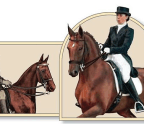
picture is worth a thousand words in explaining the bone structure that underlies the ability to freely turn the head, which is found not only in Saddlebreds but in some the plate of bone that forms the occiput is tilted backwards relative to the top of the braincase, producing an angle (marked in red) of well over 90 degrees. This displaces the joint between the skull and the atlas vertebra rearward, which in turn widens the distance between the “wing” of the atlas and the back of the mandible (the jowl). is typical of most Thoroughbreds or Quarter Horses, having less backward tilt of the occiput and thus a shorter distance between the wing of the atlas and the jowl. The bones colored red, blue and green are the squamous temporal, mastoid and paramastoid bones, which overlap in Chinese-fan fashion and are spread farther apart in horses with back-tilted occiputs.




